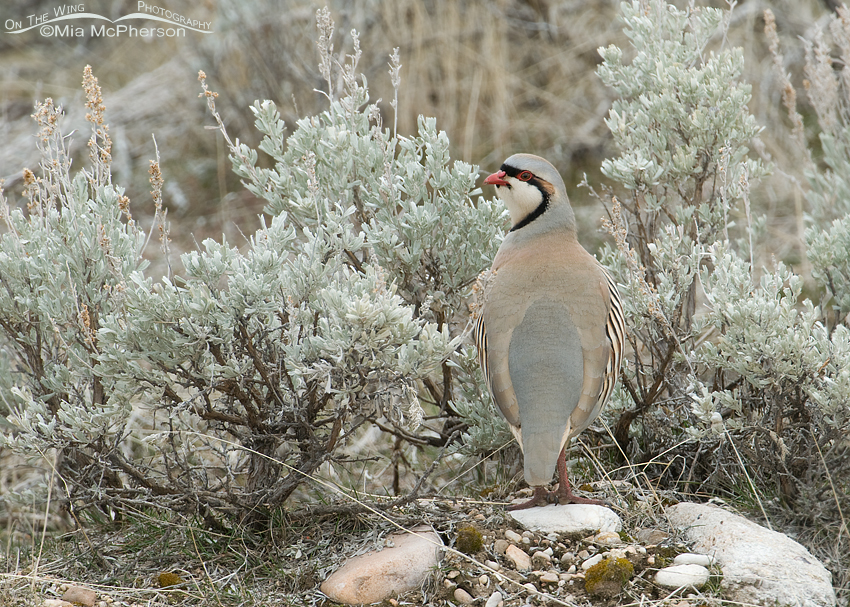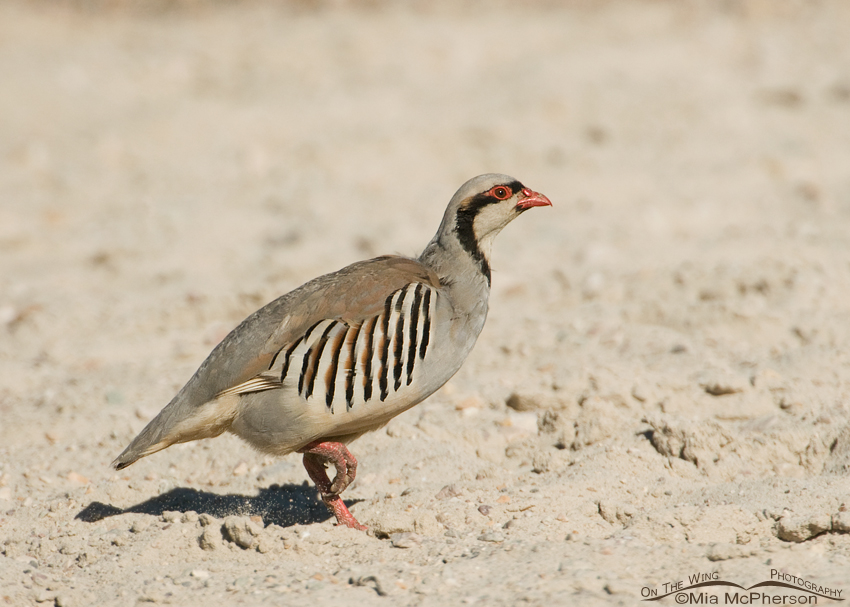Chukars
 Chukar calling in early morning light with Black Mustard in the background – Nikon D200, f6.3, 1/640, ISO 400, Nikkor 200-400mm VR with 1.4x TC at 265mm, natural early morning light
Chukar calling in early morning light with Black Mustard in the background – Nikon D200, f6.3, 1/640, ISO 400, Nikkor 200-400mm VR with 1.4x TC at 265mm, natural early morning light
I can recall vividly the first time I saw a wild Chukar on Antelope Island State Park and remember thinking “Wow, what an exotic bird!” That thought probably was a bit strange though because at the time I was living in Florida and quite often saw birds there that would definitely be considered “exotic” here in Utah.
 Chukar in sagebrush – Nikon D200, f7.1, 1/160, ISO 320, +1.0 EV, Nikkor 200-400mm VR with 1.4x TC at 325mm, low light
Chukar in sagebrush – Nikon D200, f7.1, 1/160, ISO 320, +1.0 EV, Nikkor 200-400mm VR with 1.4x TC at 325mm, low light
The fact is that Chukars are “exotic” any where they are found in North America. Chukars are an introduced upland game bird species that originally come from Eurasia. After introduction to the Great Basin feral populations became established and the Chukars have thrived in certain areas, one of those locations is Antelope Island State Park in northern Utah which is surrounded by the Great Salt Lake.
 Close up of a Chukar – Nikon D200, f8, 1/1250, ISO 400, Nikkor 200-400mm VR with 1.4x TC at 400mm, natural light
Close up of a Chukar – Nikon D200, f8, 1/1250, ISO 400, Nikkor 200-400mm VR with 1.4x TC at 400mm, natural light
Chukars have red bills, gray crowns, a cream colored throat which is bordered by a thick black area of feathers that makes me think they are wearing a V-necked sweater. The black border extends upward past the eye and across the forehead, the reddish orbital rings stands out quite well from the black feathers. Chukars are rotund birds and I believe the image above shows that quite well. To me it almost appears that the Chukar has swallowed a full water-balloon whole!
 Side view of a Chukar with Black Mustard in the background – Nikon D200, f6.3, 1/640, ISO 400, Nikkor 200-400mm VR with 1.4x TC at 265mm, natural early morning light
Side view of a Chukar with Black Mustard in the background – Nikon D200, f6.3, 1/640, ISO 400, Nikkor 200-400mm VR with 1.4x TC at 265mm, natural early morning light
Chukars have beautifully marked flanks with cream, black and slightly rufous stripes, are primarily gray with pale pinkish gray backs. Chukars have short tails, reddish legs and their wings are short and rounded.
The females are slightly smaller than the males and the females lack spurs. I only learned about the spurs today while researching this species so I’ll have to start looking for them to ID the gender of the birds I am photographing.
 Springtime Feeding Chukar – Nikon D200, f8, , 1/1250, ISO 400, Nikkor 200-400mm VR with 1.4x TC at 400mm, natural light
Springtime Feeding Chukar – Nikon D200, f8, , 1/1250, ISO 400, Nikkor 200-400mm VR with 1.4x TC at 400mm, natural light
Chukars are seed-eaters though they also eat insects. Cheatgrass; an introduced species from Eurasia, is a preferred food for Chukars, they ingest both the seeds and the green leaves. It makes perfect sense to me that they would eat a grass species that they ate in their homeland. Cheatgrass is considered an obnoxious weed in North America so I’m sure no one minds the Chukars eating their fill.
 Chukar running across the Oolitic Sand of the Great Salt Lake – Nikon D200, f6.3, 1/2000, ISO 400, Nikkor 200-400mm VR with 1.4x TC at 400mm, natural light
Chukar running across the Oolitic Sand of the Great Salt Lake – Nikon D200, f6.3, 1/2000, ISO 400, Nikkor 200-400mm VR with 1.4x TC at 400mm, natural light
Because Antelope Island is located within the Great Salt Lake there are times when Chukars can be seen scurrying along the dunes of Oolitic Sand found on the shorelines. I find the formation of Oolitic sand quite fascinating, for more information about it you can click here.
While on Antelope Island I most often hear the Chukars before I see them. They cluck often which can clue a photographer in on where they might be located. Chukars form loose flocks, I have heard the flocks called coveys or crèches but simply prefer to call them a “flock”.
 Chukar on gravel – Nikon D200, f8, 1/1600, ISO 400, Nikkor 200-400mm VR with 1.4x TC at 400mm, natural light
Chukar on gravel – Nikon D200, f8, 1/1600, ISO 400, Nikkor 200-400mm VR with 1.4x TC at 400mm, natural light
On the island you can see Chukars in different habitats. They can be seen on grassy slopes, in among the rocks and boulders, the dunes, and in areas with sagebrush and rabbitbrush. Early in the morning I often see them perched on top of the rocks or winding their way through the grasses.
 Chukar walking down a boulder – Nikon D200, f6.3, 1/400, ISO 400, Nikkor 200-400mm VR with 1.4x TC at 325mm, natural light
Chukar walking down a boulder – Nikon D200, f6.3, 1/400, ISO 400, Nikkor 200-400mm VR with 1.4x TC at 325mm, natural light
Chukars are social birds so if you see one there are probably more around. I believe there are times when the Chukars I spot on top of rocks or boulders are the “lookout” or “sentinel” bird that will alarm the others that are feeding on the ground of the presence of a predator.
 Adult Chukar with chicks – Nikon D200, f5.6, 1/1000, ISO 400, +0.3 EV, Nikkor 200-400mm VR with 1.4x TC at 400mm, natural light.
Adult Chukar with chicks – Nikon D200, f5.6, 1/1000, ISO 400, +0.3 EV, Nikkor 200-400mm VR with 1.4x TC at 400mm, natural light.
The nests of Chukars are shallow scrapes lined with grasses and breast feathers, my research indicates that they are difficult to find and I’d have to agree as I have never found or seen one. I’ve read where Chukars lay anywhere from seven to twenty-one eggs with the average being around fifteen.
I personally have seen adults with loads of chicks running all over the place. Keeping track of that many young must be akin to herding cats!
Towards the end of summer and into fall some of the adults begin to look ratty with the edges of their feathers appearing worn and often bare spots of skin are showing on or near the neck. They aren’t so “pretty” then but I’ll still photograph them.
 Chukar calling on a snow-covered rock – Nikon D200, f7.1, 1/2000, ISO 400, Nikkor 200-400mm VR with 1.4x TC at 400mm, natural light
Chukar calling on a snow-covered rock – Nikon D200, f7.1, 1/2000, ISO 400, Nikkor 200-400mm VR with 1.4x TC at 400mm, natural light
I haven’t spent a whole lot of time observing Chukars of Antelope Island during the winter but they are certainly present at that time of the year. They are not a migratory species. I hope to spend more time on the island in winter photographing them though as they are very beautiful against a fresh, white snow and sunny skies.
Mia
To view more of my Chukar photos plus facts and information about this species click here.


… like the last one, too … bless him … he’s lonely!!!
this is an outstanding post, Mia … that first shot alone is worth the price of admission … glorious light, tones, pose and the background / bokeh adds so much!!!!! Wow and wow!!!!!!
Very cool – I LOVE that last pic!
Nicole, I love that one a lot too!